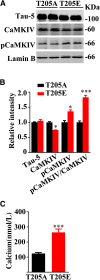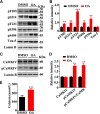Tau-Induced Ca2+/Calmodulin-Dependent Protein Kinase-IV Activation Aggravates Nuclear Tau Hyperphosphorylation
- PMID: 28646348
- PMCID: PMC5856708
- DOI: 10.1007/s12264-017-0148-8
Tau-Induced Ca2+/Calmodulin-Dependent Protein Kinase-IV Activation Aggravates Nuclear Tau Hyperphosphorylation
Abstract
Hyperphosphorylated tau is the major protein component of neurofibrillary tangles in the brains of patients with Alzheimer's disease (AD). However, the mechanism underlying tau hyperphosphorylation is not fully understood. Here, we demonstrated that exogenously expressed wild-type human tau40 was detectable in the phosphorylated form at multiple AD-associated sites in cytoplasmic and nuclear fractions from HEK293 cells. Among these sites, tau phosphorylated at Thr205 and Ser214 was almost exclusively found in the nuclear fraction at the conditions used in the present study. With the intracellular tau accumulation, the Ca2+ concentration was significantly increased in both cytoplasmic and nuclear fractions. Further studies using site-specific mutagenesis and pharmacological treatment demonstrated that phosphorylation of tau at Thr205 increased nuclear Ca2+ concentration with a simultaneous increase in the phosphorylation of Ca2+/calmodulin-dependent protein kinase IV (CaMKIV) at Ser196. On the other hand, phosphorylation of tau at Ser214 did not significantly change the nuclear Ca2+/CaMKIV signaling. Finally, expressing calmodulin-binding protein-4 that disrupts formation of the Ca2+/calmodulin complex abolished the okadaic acid-induced tau hyperphosphorylation in the nuclear fraction. We conclude that the intracellular accumulation of phosphorylated tau, as detected in the brains of AD patients, can trigger nuclear Ca2+/CaMKIV signaling, which in turn aggravates tau hyperphosphorylation. Our findings provide new insights for tauopathies: hyperphosphorylation of intracellular tau and an increased Ca2+ concentration may induce a self-perpetuating harmful loop to promote neurodegeneration.
Keywords: Alzheimer’s disease; CaMKIV; Nuclear calcium signal; Phosphorylation; Tau.
Figures





References
-
- Grundke-Iqbal I, Iqbal K, Quinlan M, Tung YC, Zaidi MS, Wisniewski HM. Microtubule-associated protein tau. A component of Alzheimer paired helical filaments. J Biol Chem. 1986;261:6084–6089. - PubMed
MeSH terms
Substances
LinkOut - more resources
Full Text Sources
Other Literature Sources
Molecular Biology Databases
Miscellaneous

